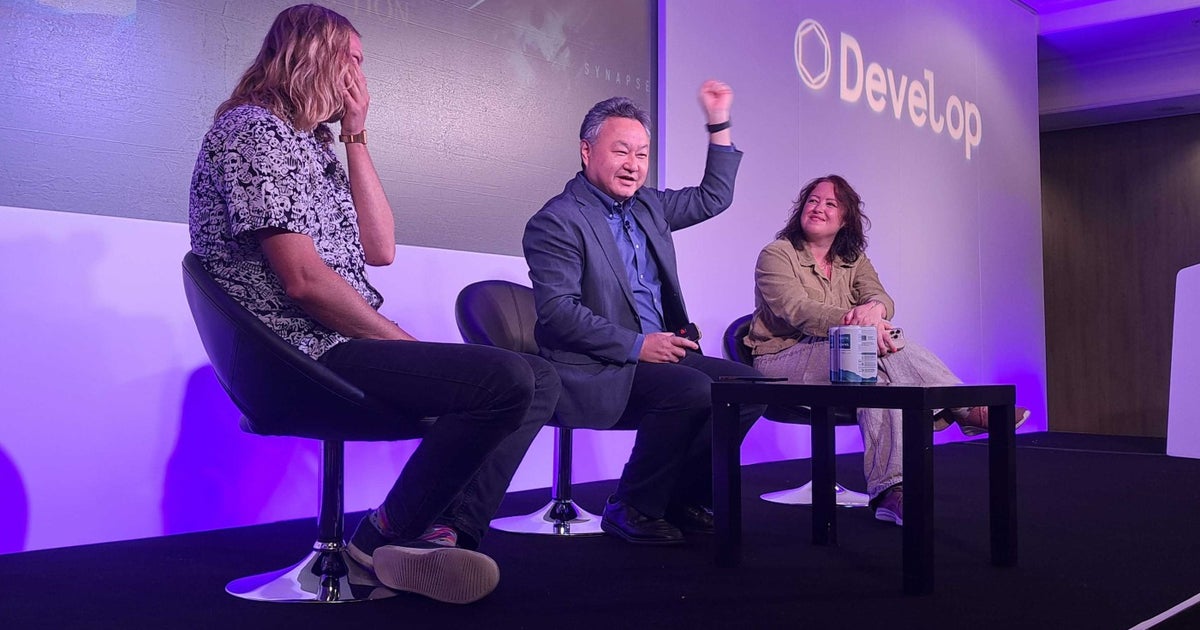What makes a great game?
It’s a question with many answers, and one that came up during this year’s Develop Brighton keynote, which featured PlayStation’s Shuhei Yoshida and Greg Rice. In a chat with Fundamentally Games COO Ella Romanos, the pair – who have decades of combined experience in working with developers, and particularly indies – shared the common traits they find within the most acclaimed games and studios.
Rice began by noting that, while there are many different crafts involved in making games, technical mastery in one or two areas is no longer enough to elevate any given title.
“Back in the day… If you had a really good art style, or maybe a really good game mechanic, maybe that was enough,” he said. “Now there are so many games out there, you have to excel across the board in most cases. [You need to have] a really beautiful art style that stands out from the crowd and is instantly recognisable, try to have mechanical gameplay hooks that are unique and different, and have a personality behind it that feels like it’s something coming from a place of creativity and passion.”
He added that developers should always aim to do something new and innovative. “I think a lot of people in this industry are chasing fads and ideas that have shown success, and when you’re doing that oftentimes you’re already behind.”
Yoshida, meanwhile, said that since the key to greatness is how a title plays. “When you press a button, what happens? That interactivity is so core to this medium. When I was managing first-party or helping indies, giving them feedback, the first thing I would do was pick up the controller and point out issues that the developers might not have seen. That’s a fundamental thing every game has to do first.”
“Some developers can describe their game in terms of the emotion they want to [evoke] in the player instead of the mechanics or genre”
Shuhei Yoshida, PlayStation
He urged developers to put their games in the hands of people who aren’t directly involved with the project, and emphasised the importance of iteration, polishing and testing.
“During any game’s development, you should be showing your game to your friends and family, bringing your game to events and watching people play – people who don’t understand the game as you do,” he said. “The repetition of iteration to improve your game is so critical.”
Clarity of vision was another recurring theme of the keynote, with both Rice and Yoshida stressing how important it is to have a clear idea of the game you want to make. Yoshida cited his experiences working with Fumito Ueda, the director and lead designer of Ico, Shadow of the Colossus, and The Last Guardian. While the first two games took four years each to develop, the third was in the works for ten years.
“The fourth game, which I’m not involved with, he may take even longer,” Yoshida laughed. “For the first three games, every time he started the project, he created a short video [about the game]. When you compare that to the final game, it’s amazing how similar they are. He has such a great idea of what he wants to accomplish. Of course, some of the features are missing or have changed during development, but the core things he wanted to accomplish for Ico, Shadows of the Colossus, and The Last Guardian, he had a clear idea [from] the beginning.
“He created the video to communicate his vision to the team – and it also helped when he pitched to the company for financing. He has such a high standard that the team has to try and reach, and oftentimes his vision is slightly above the capability of the hardware of the time. Two of these projects we had to move platform, from PS1 to PS2 or PS3 to PS4.”
Yoshida said this is a commonality shared by auteurs such as Ueda, Metal Gear creator Hideo Kojima, FromSoftware’s Hidetaka Miyazaki, and even Gran Turismo director Kazunori Yamauchi: “[They all] have a very clear vision.”
Rice added that having a clear vision can “manifest itself in a number of different ways” and emphasised that it doesn’t always need to rely on one single person. He reflected on his time at Double Fine, where founder Tim Schafer “very much ran the studio in a collaborative way.”
“That’s what I love to see, when everyone feels like they have a seat at the table. Everyone has interesting ideas that can be thrown in the mix, [so have] a group of people coming together and filling in the gaps in their knowledge, making a game together that is better than they would be able to make on their own.”
Rice acknowledged that there are plenty of successful one-person studios out there, using Animal Well director Billy Basso as an example, but pointed out that these individuals always have people who help to test the game, offer feedback, localise it and provide other forms of support. For Rice, it’s all about “being realistic about where your gaps are” and recognising where you need to be collaborating with others.
Yoshida suggested that, regardless of team size, a key formula for success is to have a strong creative lead and a strong producer.
“A lot of people in this industry are chasing fads that have shown success, and oftentimes [they’re] already behind”
Greg Rice, PlayStation
“They’re almost fighting each other the whole time, but that’s really healthy,” he explained. “When the creative lead is too strong, the game never gets finished. When the producer is too strong, the game’s creativity is not as strong. Having two of them trusting each other but butting heads from time to time creates really great results.”
When asked about developers’ most common mistakes, Rice quickly warned against “scope creep.”
“It’s easy to let a game balloon and grow, so having a really succinct vision, something that’s possible to achieve and quick to see on the screen rather than endlessly dragging out these projects [is key],” he said.
“Something you always see is indies just starting up and the first game they want to make is something narrative with lots of animation or an open world, or something like that. Starting small and with a clear vision is important.”
He added that, while story and character are important to “creating a world [players] want to live in,” it’s vital to remember that not every game needs too much detail in this area. It’s better to focus on the mechanics, or at least make them clear to people.
“I’ve had a lot of pitches where it’s 15 minutes or so of lore dumps, and it’s not until 20 minutes in that they mention ‘Oh, and this is a card game’,” Rice laughed.
Another mistake developers make, according to Yoshida, is “not asking for enough money.” He observed that studios who are not completely sure about their game concept may ask for less than they need, but he reminded developers that securing funding is a key part of forming a relationship with the investor or publisher that will help you bring your title to market.
“Every game’s development has encountered problems so you have to ask for enough money in order to overcome these issues,” he added.
For indies in particular, there’s also a danger of focusing solely on development and failing to set aside time and resources for getting the game out there.
“A lot of indies are self-publishing so they need to handle their marketing beats, their promotion, but they’re leaving that till late in the game,” Rice said. “They’re overlooking things like not starting playtesting early enough, not thinking about console port work, or underestimating the amount of time involved in finalising a game. They get wrapped up in it, and forget they need to tell the world about it throughout development.”
Yoshida also observed that publishers and scouts are constantly looking at what’s on display, and showcasing your game could help you secure the funding and support you need.
“During any game’s development, you should be showing your game to people who don’t understand it as you do”
Shuhei Yoshida, PlayStation
The conversation then shifted towards inspiration, and where the best ideas are from, with both Rice and Yoshida saying that it can be very clear when a game has a unique and often personal inspiration behind it.
“A lot of people only look to games for inspiration, and you can really feel that at times,” Rice said. “When you see something that looks at other forms of media or is inspired by day-to-day life, that’s always powerful and breaks through a really insular industry that’s often just looking at itself.”
He added that developers need a level of self-awareness and a solid understanding of what makes their game unique – and then lean into that. This can show itself during pitches; those who have a very clear vision and a game with a specific element that makes it special find it easier to describe the title succinctly.
Yoshida observed that, with so many games releasing every year, the inspiration behind the best ones is often unique and something that only those developers have access to, whether it’s a personal experience or a particular passion or interest.
He concluded that there’s one other way in which developers are able to make their game stand out: eliciting a response that goes just beyond entertainment.
“Some developers are able to describe their game in terms of what kind of emotion they want to [evoke] in the player instead of talking about the mechanics or the genre,” he said.
GamesIndustry.biz is a media partner for Develop Brighton 2024

